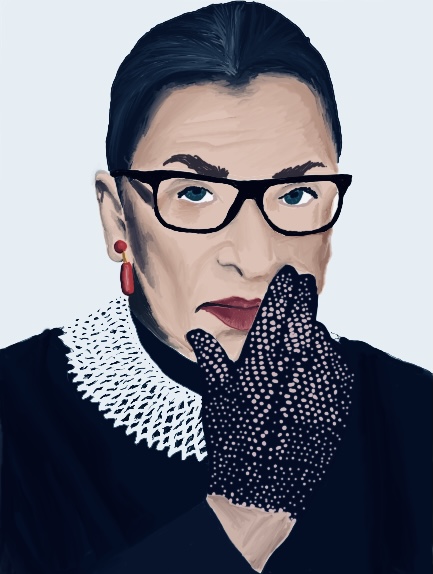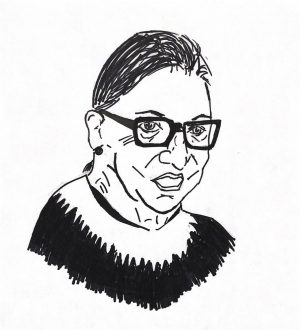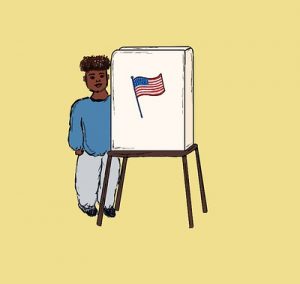RBG leaves behind a legacy of profound dissents in the face of societal injustices

Supreme Court Justice Ruth Bader Ginsburg left behind a legacy of advocacy and influential opinions.
October 29, 2020
U.S. Supreme Court Justice Ruth Bader Ginsburg, the second woman to be appointed to the court, passed on Sept.18, 2020 at her home in Washington D.C. She passed from complications of metastatic pancreatic cancer. Her death was unexpected, striking a chord across the whole nation. Chief Justice John Roberts emphasized “Our nation has lost a jurist of historic stature…We at the Supreme Court have lost a cherished colleague. Today we mourn, but with confidence that future generations will remember Ruth Bader Ginsburg as we knew her — a tireless and resolute champion of justice.” Here, we take a look at her personal life, the moments that made her “Notorious RBG,” and some of her hallmark dissenting opinions.
Personal life
Born as Joan Ruth Bader on March 15, 1933 in Brooklyn, New York, she was the second daughter of Nathan and Celia Bader. Growing up in a low-income, working class neighborhood, Ginsburg’s mother taught her the value of independence and a good education. Ginsburg famously said “my mother told me two things constantly. One was to be a lady, and the other was to be independent.”
Ginsburg’s mom didn’t attend college, rather worked in a garment factory to help pay for her brother’s college education. Ginsburg attended James Madison High School in Brooklyn and excelled in her studies. Unfortunately, her mother struggled with cancer at the time. Celia passed a day before Ginsburg’s graduation.
Ginsburg attended Cornell University, earning her bachelor’s degree in government in 1954 and finishing first in her class. While at Cornell, she met law student Martin D. Ginsburg. Meeting on a blind date (although, this date was only “blind” to Martin Ginsburg), Ruth later recalled that “he was the first boy I ever knew who cared that I had a brain.” The couple wed in 1954. However, that same year, their first years of marriage were far from easy. Martin was drafted into the military, and their first child, Jane, was born shortly after he left. After serving for two years, the couple enrolled in Harvard. Unfortunately, Martin Ginsburg contracted testicular cancer in 1956. Bader Ginsburg took on more roles than a typical graduate student, continuing to care for her daughter while helping Martin Ginsburg recover. She took notes for him and helped him study and write essays, all while continuing her own law studies.
While attending Harvard, Ginsburg developed a unique skill; learning to balance life as both a mother and a law student. However, not all was as great as it seemed. There were only eight other females in her class of more than 500. Harvard Law School proved to be a very male-dominated, toxic, and hostile environment, where “the women were chided by the law school’s dean for taking the places of qualified males.” Despite such obstacles, she excelled, eventually becoming the first female member of the prestigious Harvard Law Review.
The need to fight for gender equality
Once Martin Ginsburg recovered from testicular cancer, he accepted a job at a firm in New York. To remain together, Ruth Ginsburg transferred to Columbia Law School. There, she was elected to her school’s law review and graduated first in her class of 1959.
However, her stellar academic record was not enough. Ginsburg was faced with relentless gender discrimination while searching for a job. According to the ACLU, when she was recommended for a clerkship with Supreme Court Justice Felix Frankfurter by Harvard Law School Professor Albert Sachs, Frankfurter responded that he wasn’t ready to hire a woman and Sachs to recommend a man. Such was given that she worked for a top law firm in New York, summer of her sophomore year in law school. “I thought I had done a terrific job, and I expected them to offer me a job on graduation,” Ginsburg recalled.
She received no job offers a 2 responded from the 12 law firms she interviewed at. Eventually, Ginsburg was hired to clerk for Judge Edmund L. Palmieri of the U.S. District Court for the Southern District of New York from 1959-1961. Afterwards, she found herself on an academia pathway, opting to work on Columbia Law School’s International Procedure Project instead of new offers at law firms. She found herself on the faculty of Rutgers Law School in 1963, but a woman in academia wasn’t a common feat. Upon discovering that her salary was lower than her male colleagues, joining an equal pay campaign was her next step, resulting in substantial pay increases.
Her own experiences shaped her worldview, as Ginsburg began to handle sex discrimination complaints referred to her by the New Jersey affiliate of the ACLU, envisioning that both men and women would “create new traditions by their actions, if artificial barriers are removed, and avenues of opportunity held open to them.” Such experiences motivated her to found the ACLU Women’s Rights Project in 1972, aimed at empowering poor women, women of color and immigrant women, subjected to gender bias and pervasive equity barriers, through litigation, community outreach, advocacy and public education. Ginsburg’s perspective and visions, although bold, were not limited to a singular area of society. The ACLU Women’s Rights Project focuses it’s work in employment, violence against women, criminal justice and education.
On January 21, 1972, Ginsburg became the first woman to be granted tenure at Columbia Law School, during a time where women and people of color were underrepresented on Columbia’s faculty. The New York Times reported five days later, January 26, 1972, on the subject. Dean Micheal Sovern emphasized that Ginsburg was “‘so distinguished a scholar,’ that her credentials and honors would stand out in any catalogue of professors.”
According to the Columbia Law School webpage, her visions and approach were unique: “She masterminded a step-by-step approach to constructing a groundbreaking body of gender-equality jurisprudence, which earned her the reputation as the legal architect of the women’s movement.” Rather than only fighting for women who were discriminated against, she also fought for men who had been denied legal benefits designated for women. Her approach proved itself; in the 1970s, “while teaching full-time at Columbia, she argued six successful landmark cases before the U.S. Supreme Court and oversaw more than 300 sex discrimination cases on the ACLU’s women’s rights docket” as a lawyer and civilian. Her efforts and legacy founded upon fighting injustices against women and minorities carried her to serve as a judge for 13 years in the U.S. Court of Appeals, and later for 27 years as a Supreme Court Justice.
A peak at some her most influential cases
Writing about every single case Ginsburg fought would be more than an article. Rather, it would likely be a book. But, here are some of her most influential cases, establishing her both in the legal field and as a staunch equality advocate.
Reed v. Reed
According to the Supreme Court Historical Society, a law enacted in 1864 in the state of Idaho, required that “when the father and mother of a deceased person both sought appointment as administrator of the estate, the man had to be preferred over the woman.”. A minor named Richard Lynn Reed died without a will at the age of 16, and his divorced parents, Sally and Cecil, each filed to be administrator of their son’s estate. However, the probate court referred to the 1864 statue and chose the father over the mother, despite the fact that the mother had filed first. As a matter of fact, the Idaho Supreme Court ruled that generally “men are better qualified to act as [administrators] than are women,” and a preference for men served a legitimate purpose of “curtailing litigation over the appointment of administrators.”The opinion was unanimous.
The case eventually made its way to the U.S. Supreme Court. In 1971, as a volunteer attorney for the ACLU, Ginsburg wrote the plaintiff’s brief, and it relied heavily on the Fourteenth Amendment. Ratified in 1868, the amendment granted citizenship to all people born or naturalized in the United States (including former slaves) and guaranteed citizens “equal protection under the laws.” Ginsburg argued that denying the mother on the fact that she is a woman violated the equal protection clause under the Fourteenth Amendment. As a result, the U.S Supreme Court unanimously agreed, striking down the Idaho Statute, which was the first time the Court applied the Equal Protection Clause to a law that discriminated on the basis of gender. The case showed how the court was starting to catch up with the rest of society, as it “clearly signaled a shift in attitude: state legislatures no longer would be able to assume that women could be excluded simply on the ground of administrative convenience.”
Frontiero v. Richardson
According to the Supreme Court Historical Society, U.S. air force lieutenant Sharron Frontiero sought an increased housing allowance plus dental and medical benefits for her husband after she married Joseph, a full-time college student. Under the federal law, “a married man in the armed forces was automatically entitled to such perquisites, whether his wife earned a lot or a little, but a married woman was unable to obtain them unless she could prove that her husband was dependent on her for more than one-half his support.”
Ginsburg wrote an amicus brief*, arguing that gender discrimination hurts men too. Similarly to Reed v. Reed, she asked in an oral argument, “why did the framers of the 14th Amendment regard racial [discrimination] as odious? Because a person’s skin color bears no necessary relationship to ability. Similarly…a person’s sex bears no necessary relationship to ability.” Ultimately, the plurality of the Supreme Court set a new precedent. First, they declared that due to United States’ long history of gender-based discrimination, “the court should use a strict standard of judicial scrutiny for laws that used sex as a classification.”
Craig v. Boren
Craig v. Boren is quite a unique case, in which the law in question was a statute in Oklahoma that allowed women to purchase beer with an alcohol content of 3.2 at 18 but forbade men to purchase it before the age of 21. Although neither men nor women could purchase harder beer until the age of 21, the age differential in the statue was leftover from before Oklahoma became a state. Oklahoma State University freshman Mark Walker decided to challenge the beer statute in federal court, especially since the law imposed penalties on the person who sold the beer rather than to those who purchased it, later joined by Co-Plaintiffs, Carolyn Whitner and Curtis Craig.
Ginsburg, working as a counsel to the Women’s Rights Project at the ACLU, stepped in to offer assistance, emphasizing that she was “delighted to see the Supreme Court is interested in beer drinkers.” According to the Supreme Court Historical Society, Ginsburg’s amicus brief* didn’t speak much to standard review. Rather, she emphasized the disparity in age requirement reflected outdated stereotypes. The Supreme Court agreed, setting a new precedent that laws in regards to sex should pass on “immediate scrutiny.” In other words, any law that mentioned sex or gender had to undergo a standard of judicial review to determine it there was a legitimate reason for such.
United States v. Virginia
Many thought that Craig v. Boren would mark the end of any cases arriving to the Supreme Court regarding gender-based equal protection, as it set a precedent. However, that was not the case, as 20 years after Craig, a case arrived at the Supreme Court, from the Court of Appeals, involving the Virginia Military Institute (VMI), a public all-male school. In 1990, a female high school student from Northern Virginia filed a complaint with the U.S. attorney general, alleging that “VMI’s male-only admission policy was a violation of the constitution’s guarantee of equal protection.” Considering that VMI was the only public institution of higher education in Virginia at the time that considered sex as an admissions factor out of fifteen public institutions, the Department of Justice filed suit in federal district coty under the Civil Rights Act of 1964.
At a time where Ginsburg was now serving on the Supreme Court, following a six-day trial, the Court of Appeals ruled in favor of VMI in June 1991, stating that there was an “important governmental objective: to provide the choice of a single-gender educational environment.” The court further emphasized that exclusing one sex from VMI was “in fact, not only substantially related to achieving the goal of providing a single-gender environment-it was the only way to achieve it,” and that while some women might thrive at VMI, most wound’t and “educational systems are not designed for the exception but for the mean.”
As a result, the Justice Department and Virginia sought review in the Supreme Court in 1995, leading to an abundance of amicus briefs* from women’s rights organizations, attacking the Court of Appeals’ decision. Interestingly, they didn’t just advocate for reaffirmation of the Craig v. Boren standard. Rather they “invited the Court to announce that gender discrimination, like race discrimination, would henceforth be subject to the strict scrutiny test,” further emphasizing that sex, like race, was an “immutable characteristic” bearing no relation to ability, connecting that women have bene subject to sex discrimination for years.
Ginsburg announced the court majority opinion from the bench on June 26, 1996, ruling that “the lower courts erred in holding that VMI did not have to admit women.” At the time of VMI’s founding in 1839, women were excluded from all higher education because “[h]higher education was considered dangerous for women.” Ginsburg explained that the fear of women attending VMI destroying the adversative system and the school was “a judgement hardly proved, a prediction hardly different from other ‘self-fulfilling prophecies’…once routinely used to deny rights or opportunities.”
To prove her point, she provided some examples, one being women barred from being lawyers in 1876, a ruling from a state court that was intended to “grade up” the profession. Another was how medical facilities prevented women from attending their schools for fear of such evils as women and men jointly displaying “the secrets of the reproductive system.” Another example barred women from joining the police force because their presence alone would “undermine male solidarity,” deprive the men on the force of “adequate assistance,” and “lead to sexual misconduct.” She concluded by showcasing women’s performance success once the federal military academic and services were open to them, declaring how VMI had “fallen far short of establishing the ‘exceedingly persuasive justification’…that must be the solid base for any gender-defined classification.
Ledbetter v. Goodyear Tire & Rubber Co.,
Lily Ledbetter was employed as a supervisor for Goodyear Tire & Rubber Company at its Gadsden, Alabama plant from 1979 to 1998. However, despite her position, her salary at the end of her tenure was $3,727.00, strikingly low compared to her male co-workers. The lowest a male was paid at the end of their tenure was $4,286.00, while the highest a male was paid was $5,236.00. Ledbetter filed a complaint with the Equal Employment Opportunity Commision (EEOC), then sued Goodyear under Title VII of the Civil Rights Act of 1964, “alleging that poor performance evaluations because of her sex resulted in lower pay than her male coworkers.”
Despite a jury awarding Ledbetter over $3.5 million back in pay and damages, not only did the district judge reduce the amount to $360,000 but the Court of Appeals for the Eleventh Circuit reversed the compensation. Their claim was that Ledbetter’s claim wasn’t filed in a timely manner, emphasizing that title VII requires that a charge must be filed with the EEOC within 180 to 300 days, depending on a multitude of factors. The Court also emphasized that “there was insufficient evidence to prove that Goodyear acted with discriminatory intent in making only two pay decisions that occurred within the 180-day filing deadline.”
The case made its way to the Supreme Court, and the justices were left to decide what circumstances could a plaintiff allege illegal pay discrimination under Title VII, given that the disparate pay is received during the statutory limitations period, but is also the result of intentionally discriminatory pay decisions that occurred outside the period. The majority ruled in favor of Goodyear, that discriminatory intent “must occur during the 180-day statutory period, and thus, Ledbetter’s claim was untimely filed.”
However, Ginsburg dissented from the majority. Joined by Justices Steven, Souter, and Bryer, she argued that pay disparities are not the same as discrimination that’s obvious, like holding back a promotion or firing someone abruptly, as those kinds allow the employee to recognize it immediately and take action. Ginsburg articulated that pay discrimination is “hidden from sight,” occurring little by little over an extended period of time, explaining that the ideal approach to view salary setting as would be to “treat each payment of a wage or salary infected sex-based discrimination’ as an unlawful employment practice.”
The Lilly Ledbetter Fair Pay Act was signed into law in 2009, “which reversed the Supreme Court’s decision and makes it clear that each discriminatory paycheck resets the 180-day limit to file a claim, helping to ensure that individuals subjected to illegal pay discrimination may effectively assert their rights.”
Notorious RBG lives on
Her career as a women’s rights activist and Supreme Court Justice bled into pop culture as well. She became an icon, appearing in children’s books, movies, stickers, and more. She earned the nickname of “Notorious RBG,” a play on rapper Biggie Smalls’ Notorious B.I.G. nickname, when New York University law student Shana Knizhink coined the nickname in 2013. Ginsburg told NBC in 2017 that Knizhink started a Notorious RBG blog on Tumblr after being disappointed in the Supreme Court’s decision in the Shelby County case, “the decision that held a key part of the Voting Rights Act of 1965 no longer constitutional.” Turning her anger into something positive, she blogged about Ginsburg’s dissent, and it took off.
Her seat on the Supreme Court is now up to be filled, and President Trump is attempting to fill her seat with Amy Coney Barret before the presidential election, someone whose views are drastically different than Ginsburg’s. However, it’s undeniable that there won’t be another Ruth Bader Ginsburg, she was uniquely herself and advocated for those who lacked a voice.
*Amicus brief: according to the Public Health Law Center at Mitchell Hamline School of Law, “amicus briefs are legal documents filed in appellate court cases by non-litigants with a strong interest in the subject matter.” Such briefings advise the court of any relevant or additional information and/or arguments that the court may take into consideration. An amicus brief is filed by an outside party, hence nearly anyone who is interested in a case can file a brief.




